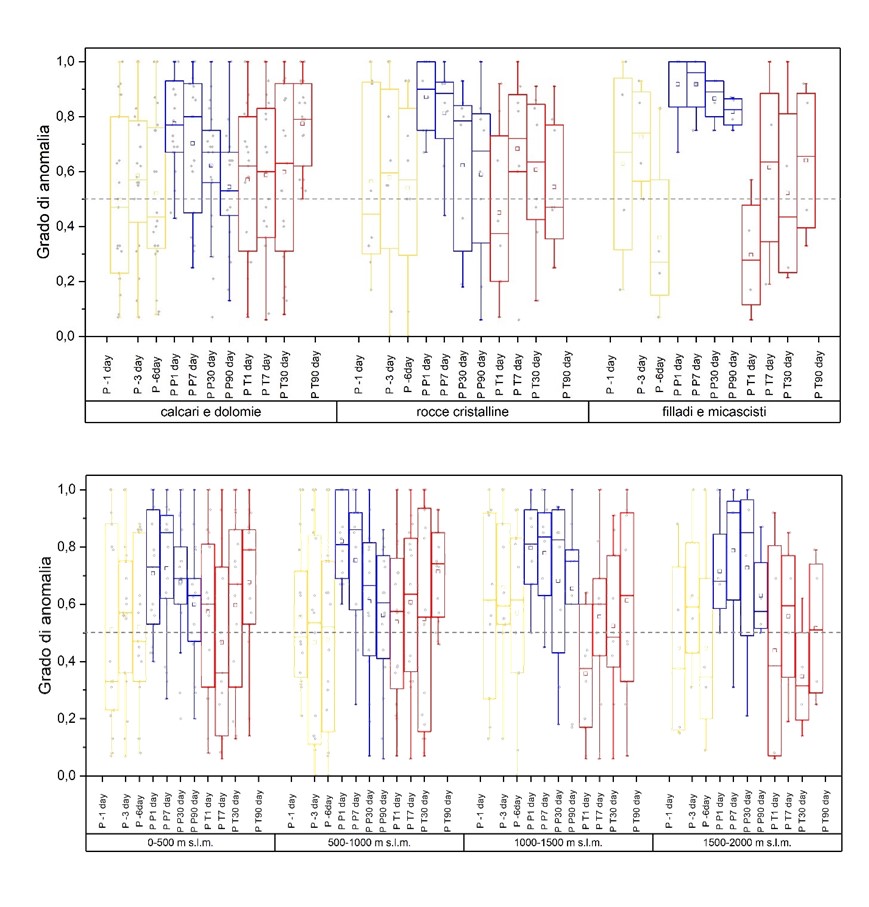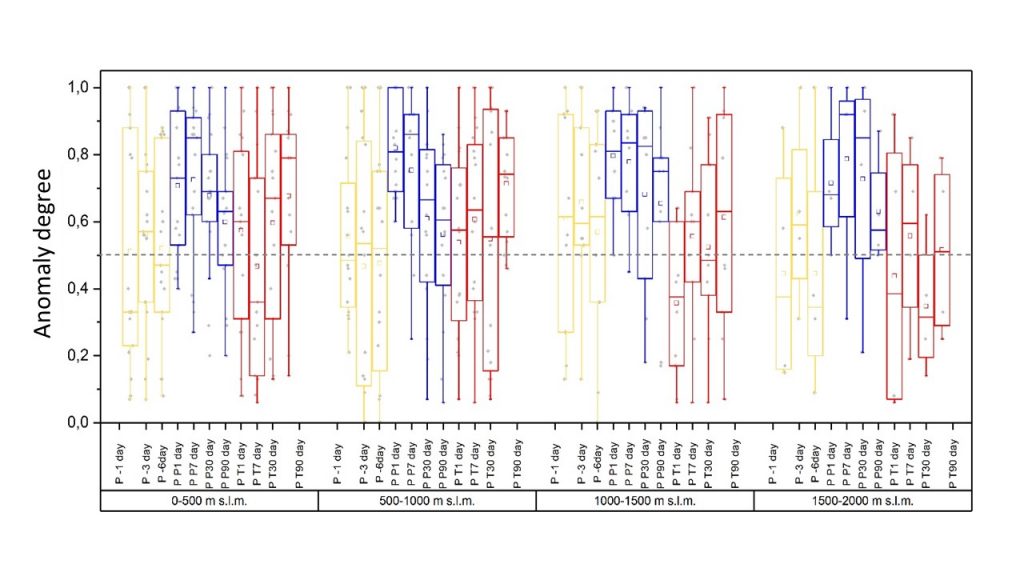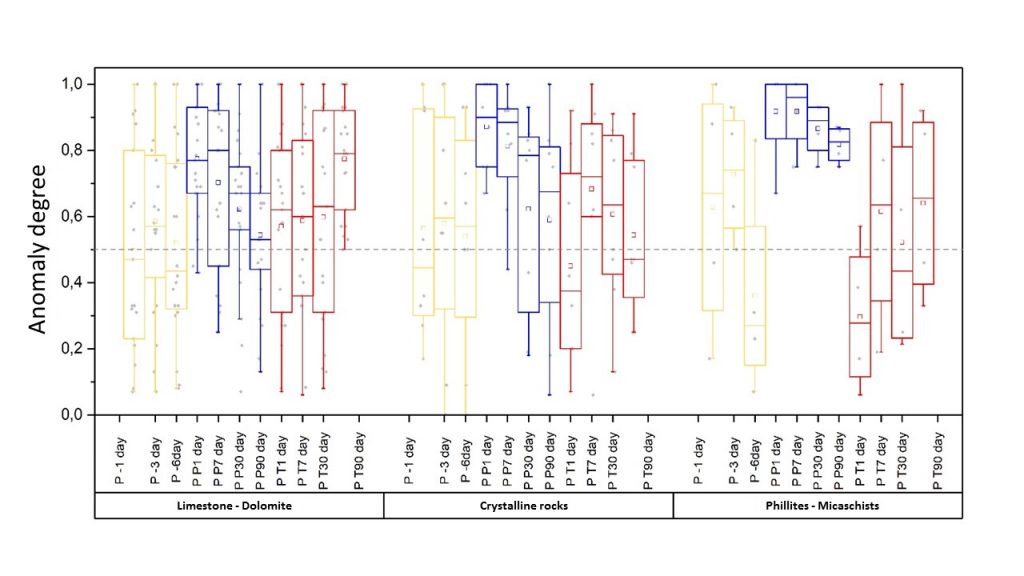[:it]
Obiettivi
Il WP studia la relazione tra l’innesco di un crollo e le condizioni meteoclimatiche come: precipitazioni estreme, precipitazioni antecedenti, scioglimento delle nevi e del ghiaccio, temperature estreme e fluttuazioni della temperatura. Le relazioni sono studiate analizzando gli eventi passati raccolti nel WP1 con tecniche statistiche multivariate (regressione multipla, regressione logistica, analisi discriminante) che correlano gli eventi di caduta massi (variabile dipendente) con i dati di eventi geologici, morfologici e scatenanti disponibili (variabili indipendenti). Questa analisi consente di definire le relazioni tra condizioni meteoclimatiche e l’innesco di frane, al fine di migliorare la simulazione dell’effetto dei futuri cambiamenti climatici sulla probabilità di innesco.
Risultati
Le analisi sono state condotte secondo il metodo proposto da Paranunzio et al. (2015) per 50 eventi di caduta massi nelle Prealpi Lombarde compresi tra il 2009 e il 2018, considerando valori di temperatura e precipitazione per diversi intervalli di tempo antecedenti ai crolli.

In figura si vede il Box plot delle variabili climatiche associate all’evento discretizzate per macrogruppi litologici caratterizzanti l’area del fenomeno. Dove il dato è più consistente si nota un’assenza nel legame con le variabili in esame. Per le rocce foliate, dove il campione è poco numeroso, si osserva un’influenza per i termini di precipitazione giornaliera (P P1 day), settimanale (P P7 day), mensile (P P30 day) e trimestrale (P P90 day) (anomalie positive) e temperature giornaliere (P T1 day) (anomalia negative). La stessa analisi è stata fatta per classi altitudinali al fine di cercare eventuali relazioni con oscillazioni di temperatura.
Dall’analisi complessiva dei dati si può concludere che:
- La variabile più correlata ai crolli è la precipitazione a 1 giorno (P1day)
- Non si osserva una significativa variazione con la quota. Questo è dovuto probabilmente al fatto che gli eventi indagati non interessano alte quote e sono principalmente localizzati lungo le vie di comunicazione a media e basse altitudini.
- Le diverse litologie non mostrano variazioni apprezzabili ad eccezione di filladi e micascisti che appaiono più sensibili alle precipitazioni rispetto alle altre litologie.
Il distacco in massa di grandi volumi di roccia da pareti rocciose ripide e di forte rilievo può essere all’origine di fenomeni definibili come crolli a grandi energie (EER). Questi processi possono generare fenomeni di disintegrazione del blocco al momento del suo impatto con un ostacolo, sia esso terreno o roccia. Tale processo di disintegrazione genera una catena di fenomeni che provocano condizioni di rischio estremamente elevate. Lo schema della figura sottostante mostra come il processo abbia luogo e delle fasi che lo compongono. Dopo l’impatto del blocco con un ostacolo, a seguito di una fase di caduta libera, si verifica la frammentazione che lo disintegra completamente e in modo quasi istantaneo. I frammenti di maggiori dimensioni hanno sufficiente energia cinetica da consentire la prosecuzione delle traiettorie balistiche . La parte più fine, invece, forma una sospensione (nuvola di polvere) che dopo essersi spostata dalla zona sorgente inglobando aria si deposita su una areale abbastanza vasto rispetto alla zona di arresto dei blocchi di maggiori dimensioni.

La figura sottostante mostra alcuni eventi avvenuti nelle Alpi e che sono stati accompagnati dalla formazione della nuvola di polvere che si sposta lungo il pendio a elevata velocità. Tale nuvola può causare la chiusura di infrastrutture viarie, a seguito della riduzione della visibilità nonché danni consistenti a strutture, edifici e copertura boschiva a causa dell’elevata velocità e abrasività delle nubi stesse nonché delle proiezioni balistiche ad elevata velocità di piccoli frammenti. Tali frammenti si comportano come veri e propri proiettili con elevata capacità di penetrazione all’impatto.

La figura sottostante mostra una scansione al microscopio elettronico che evidenzia la forma e dimensione delle particelle che compongono le polveri depositate, che raggiungono spesso dimensioni pari o inferiori a quella dei cristalli presenti all’interno della roccia stessa.

A partire dai campioni di polveri raccolte a seguito degli eventi è possibile descrivere la distribuzione granulometrica di tali polveri. La descrizione delle curve granulometriche delle polveri tramite diverse distribuzioni statistiche rende possibile la stima della quantità di polvere prodotta, l’estensione della superficie di deposizione nonché l’energia necessaria per generare la frammentazione (energia di frammentazione).

[:en]
Objectives
The WP study the relationship between rockfall onset and meteoclimatic conditions such as: rainfall extremes, antecedent rainfall, snow- and ice-melt, temperature extremes and temperature fluctuations. The relationships will be studied by analysing past events collected in WP1 with multivariate statistical techniques (multiple regression, logistic regression, discriminant analysis) relating the rockfall events (dependent variable) with available geological, morphological and triggering event data (independent variables). This analysis allows for defining functional relationships among meteoclimatic conditions and rockfall triggering that can help simulating the effect of future climatic changes on rockfall triggering probability.
Results
The analysis are conducted according to the method proposed by Paranunzio et al. (2015) for 50 rockfall events in the Lombard Prealps between 2009 and 2018, considering temperature and precipitation values for different time intervals prior to the collapses. The method is aimed at identifying anomalies in the behavior of certain variables for the years in which events occurred. The greater the degree of anomaly, the greater the control that a certain variable seems to have exercised on the triggering of events in those specific years.


The figure shows the box plot of the climatic variables associated with the event, discretized by lithological macro-groups characterizing the area of the phenomenon. Where the data is more consistent, there is an absence in the link with the variables under examination. For foliate rocks, where the sample is not very numerous, an influence can be observed for the terms of daily precipitation (P P1 day), weekly (P P7 day), monthly (P P30 day) and quarterly (P P90 day) (positive anomalies) and daily temperatures (P T1 day) (negative anomaly). The same analysis is done for altitudinal classes in order to look for possible relationships with temperature oscillations.
From the overall analysis of the data it is possible to conclude that:
1) The variable most related to collapses is 1-day precipitation (P1day)
2) There is no significant change with elevation. This is probably due to the fact that the investigated events do not affect high altitudes and are mainly located along the communication routes at medium and low altitudes.
3) The different lithologies do not show appreciable variations expect for phyllites and mica schists that appear more sensitive to precipitation than the other lithologies.
We recently defined an Extremely Energetic Rockfall (EER) as the process of a boulder striking the ground with high kinetic energy after a free ballistic flight or after rolling (a process that normally does not take away much energy) of several hundred meters. The ensuing process of disintegration gives origin to a sequence of phenomena involving some different hazardous conditions. The figure below shows how this process takes place. When the block hits the ground at high energy, it is completely disintegrated. The air is highly perturbed to the point of sustaining a shock wave, while the lager fragments have a sufficient kinetic energy to be shot in the air. The finer part forms a suspension (dust cloud) which after moving from its source area downslope, finally settles.

The figure below shows some previous events where the formation of a dust cloud and its downward motion is evident. Such cloud may prompt the facilities closure, since it reduces the visibility. Closer to the impact point, the fragments of higher dimension abrade the surfaces and, hence, are hazardous to the building, objects and in some cases cause losses of human lives.

The figure below illustrates an electronic microscope image showing the composition as well as the shape and size of the particle constituting the powder.

It is possible to interpolate the granulometric curves of the powder particles with many distributions and, thereby, to assess the amount of generated powder, its deposition surface as well as the energy occurred to generate the fragmentation (fragmentation energy).
